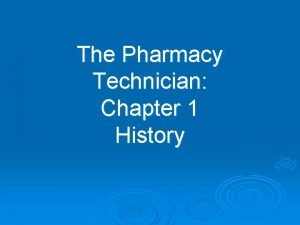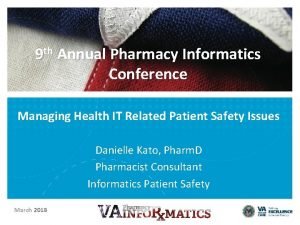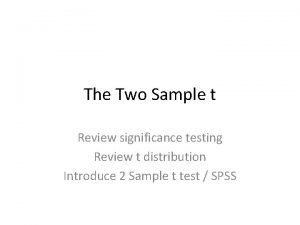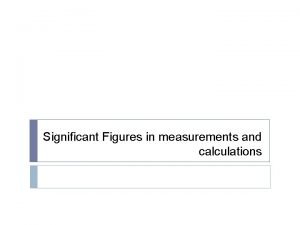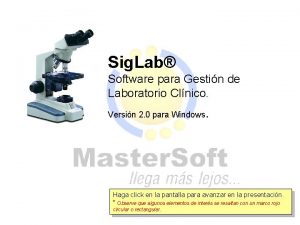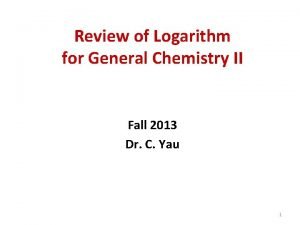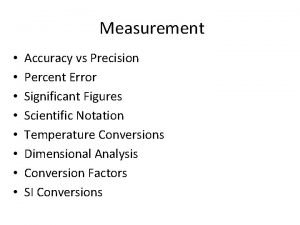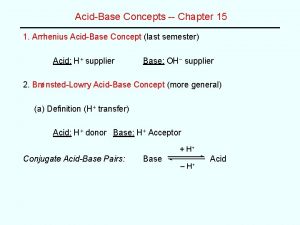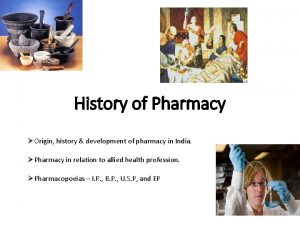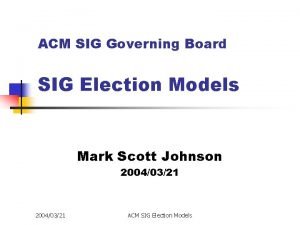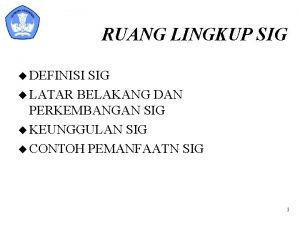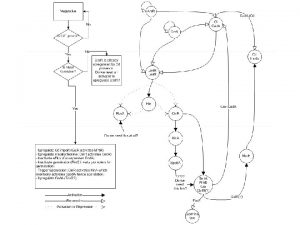History of Pharmacy SIG Teaching History of Pharmacy
















































- Slides: 48

History of Pharmacy SIG Teaching History of Pharmacy According to the AIHP Guidelines: C. Pharmacy Regulation via State and Federal Governance Created by David M. Baker, BS Pharm, MBA, JD Western New England University College of Pharmacy & Health Sciences Developed by the Teaching History of Pharmacy Committee of the History of Pharmacy SIG, 2017 -18 Picture: Pharmacist at People’s Drug Store No. 5, Washington, DC, c. 1920. Library of Congress Prints and Photographs, LC-USZ 62 -129891

State Pharmacy Law Development • Initially, in early 1800 s, the few attempts at “regulation” of profession were typically limited to local level laws • As slowly moved toward state level regulation, early attempts often were developed in combination with medical practice laws.

State Pharmacy Law Development • 1808 - Territory of Orleans (became Louisiana in 1812): pharmacists had to prove qualifications; examined by Board of Physicians; banned sale of deteriorated drugs; restricted sale of poisons • 1840 - 1 st state board of pharmacy • 1852 - pharmacy act was repealed

One of the First State-Licensed Pharmacists

State Pharmacy Law Development • Other State Pharmacy Acts: • 1817 - South Carolina • 1838 - penalty component was repealed • 1825 - Georgia • 1852 - Alabama

State Pharmacy Law Development – Common Law • Thomas v. Winchester, 6 N. Y. 397 (N. Y. 1852) – established duty to dispense (label) correctly • Fleet and Semple v. Hollenkemp, 52 Ky. (1 B Mon. ) 219 (1852) – changed pharmacy purchases from caveat emptor to caveat vendor • Burgess v. Sims Drug Co. , 86 NW 307 (Iowa 1901) – pharmacists & employers equally liable • Peters v. Johnson, 41 SE 190 (W. Va. 1902) – high degree of care & prevent foreseeable harm

State Pharmacy Law Development • State regulation of pharmacy practice prior to 1870 did not typically involve pharmacists directly: • against drug adulteration • restricted poison sales • prohibited advertising or selling of abortifacients

State Pharmacy Law Development • 1869 - APh. A Meeting: after much rancorous debate concerning rural areas without pharmacies and a fear of bureaucracy, a model state pharmacy act was drafted. This would quickly be adopted by states as their state law.

State Pharmacy Law Development • Adoption of Model Pharmacy Act, creating Pharmacy Boards and standards for pharmacists and pharmacy practice: • 1870 - Rhode Island first • By 1878 - 8 more states and D. C. • In the 1880 s - 21 more states • In the 1890 s - 12 more states

State Pharmacy Law Development • In 1900, the Model Pharmacy Practice Act was revised by APh. A without any controversy. • Currently, the Model Pharmacy Practice Act is updated and maintained by the National Association of Boards of Pharmacy.

Federal Pharmacy Law Development • Precipitating Events: • Fraudulent production, advertising and distribution of fake smallpox vaccine, at extravagant prices. • Vaccine Act of 1813 • Purpose was to encourage and increase smallpox vaccinations. • Created a single federally-appointed agent, whose responsibilities were to: • preserve the genuine smallpox vaccine matter; and • to furnish the same to any citizen of the United States, whenever it may be applied for, through the medium of the post-office (carried free of charge by the post office). • Repealed May 4, 1822 - result of an 1821 outbreak of smallpox in North Carolina, which was traced to contaminated vaccines provided by Dr. John Smith while in the capacity of the federal agent charged with preserving and distributing genuine vaccine.

Federal Pharmacy Law Development • Precipitating Events: • Complaints by pharmacies that drug products (crude product) were adulterated or not of specified concentrations. • Claim was that this was primarily IMPORTED product. • Drug Importation Act of 1848: • Examined all imported products for quality, purity and fitness for purpose. • Established Pharmacopoeia of the U. S. and U. S. Dispensatory as official standards. • Administered by the Department of the Treasury.

Federal Pharmacy Law Development • Precipitating Events: • Tetanus contamination in diphtheria vaccine. • Most vaccines produced on farms using production animals (horses, cattle). • Biologics Control Act of 1902: • Treasury Department licensed and inspected biologics manufacturers, and regulated production and labeling of biologics. • National Sanitary Board (the Surgeon. Generals of the Army, Navy and Marine. Hospital Service) promulgated regulations.

Federal Pharmacy Law Development Muckraking Journalism – Early 20 th Century

Federal Pharmacy Law Development • Precipitating Events: • Muckraking journalism: Upton Sinclair’s The Jungle (meat packers) and Samuel Hopkins Adams’ Great American Fraud (patent medicines) • Harvey Wiley’s advocacy (worked in Agriculture Dept. ’s Bureau of Chemistry) • Pure Food and Drug Act of 1906: • Defined “drug, ” and regulated the adulteration or misbranding of drugs. • Regulations promulgated jointly by the Treasury, Agriculture, and Commerce & Labor Departments; Bureau of Chemistry (in Ag. Dept. ) performed any necessary tests. • Established U. S. Pharmacopoeia and National Formulary as drug standards.

Federal Pharmacy Law Development • Precipitating Events: • Realization of the extent of addiction to opiates and other narcotics among the general public through prescription and patent remedies. • International Treaty concerning addictive substances at the Hague in 1912, to which the U. S. was a signatory. • Harrison Anti-Narcotic Act of 1914: • Established control over the manufacture, distribution and dispensing of certain addictive substances (e. g. , opium, morphine and cocaine) in high concentrations, primarily through taxation and required labeling.

Federal Pharmacy Law Development

Federal Pharmacy Law Development • Precipitating Events: • Many had advocated for new law for years due to ineffectiveness of 1906 law – could only prosecute fraudulent, not misleading labelling, due to 1911 US Supreme Court decision • Sulfanilamide Elixir (Massengill) tragedy of 1937 – used diethylene glycol as solvent; 107 deaths plus suicide death of creator • Food, Drug and Cosmetic Act of 1938: • Definition of “drug” expanded • to include affecting body structures even in the absence of disease (prevention); and • by addition of the Homeopathic Pharmacopoeia of the U. S. as a drug standard.

Federal Pharmacy Law Development Food, Drug and Cosmetic Act of 1938 (continued): • Drug labeling requirements became more strict • A drug could not be sold unless an application for approval was on file with the FDA. • The newly created Food and Drug Administration (FDA) was given general administrative powers.

Federal Pharmacy Law Development • Precipitating Events: • No standard as to what required a prescription. Previously, decision was left to individual manufacturer to make. • Durham-Humphrey Amendment or Prescription Drug Amendment of 1951: • Established two classes of drugs - prescription and over-the-counter • Established label and labeling requirements unique to prescription drugs (exempted from “adequate directions for use” requirement)

Federal Pharmacy Law Development • Precipitating Events: • - Use of thalidomide in pregnant women for morning sickness from 1957 to 1962 (Europe) – teratogenic effects: death and phocomelia (estimated 10– 20, 000 cases worldwide) • Drug Efficacy Amendment of 1962 (or Kefauver. Harris Amendment): • Established Good Manufacturing Practices (“GMPs”) • Transferred regulation of prescription drug advertising from the Federal Trade Commission (“FTC”) to the FDA

Federal Pharmacy Law Development Drug Efficacy Amendment of 1962 (continued): • Required informed consent of all human research subjects. • Required reporting of adverse drug reactions by manufacturers to FDA. • New drug approval now required proof of efficacy in addition to safety.

Federal Pharmacy Law Development Federal Comprehensive Drug Abuse Prevention and Control Act or Controlled Substances Act of 1970 • Established the Drug Enforcement Administration (DEA) from four different federal agencies, including BNDD (Bureau of Narcotics & Dangerous Drugs). • Created five controlled substance schedules, and prescription limitations for each class. • Established criminal liability for illegal possession or trafficking in controlled substances.

Federal Pharmacy Law Development Poison Prevention Packaging Act of 1970 • Requires child-resistant (= 80% of children <5 y. o. cannot open but 90% of adults can), NOT childproof, packaging for all drugs and cosmetics (and various other hazardous household substances) unless the product is: • on a list of excepted products; • a one size OTC product for elderly or handicapped patients; or • a prescription drug, and the prescriber or patient requests noncompliant packaging (it is recommended to obtain such requests in writing).

Federal Pharmacy Law Development Medical Device Amendment of 1976 • FDA has the responsibility of classifying all medical devices as: Class I - general controls, ex. = sphygmomanometer; Class II - specific performance standards, ex. = IV fluid pump Class III - pre-market approval since are life-supporting or life-sustaining, ex. = heart pacemaker

Federal Pharmacy Law Development Medical Device Amendment of 1976 (continued) • FDA must establish standards of performance for all medical devices. • FDA must establish a system of premarket testing and review for Class III medical devices. • FDA must develop a system of postmarket surveillance of medical devices.

Federal Pharmacy Law Development Federal Anti-Tampering Act of 1982 • Precipitating Event: • Drug tampering of Tylenol cases that occurred in the Chicago area during 1982. Seven deaths occurred due to lacing with potassium cyanide. • Requires certain (not all) OTC drugs, cosmetics and devices to be manufactured in tamper-resistant (not tamper-proof) packaging, or it will be considered misbranded and/or adulterated by the FDA.

Federal Pharmacy Law Development Orphan Drug Act of 1983 • Precipitating Events: • Diseases affecting small population numbers – the culminating disorder: AIDS • Provides tax and exclusive licensing incentives to manufacturers to develop and produce drugs intended for diseased populations of < 200, 000 people within the U. S.

Federal Pharmacy Law Development Drug Price Competition and Patent-Term Restoration Act (Waxman-Hatch Amendment of 1984) • Precipitating Event: • FDA had created a “side” method of approval without real authority • Made into law the Abbreviated New Drug Application (“ANDA”) process for generic drug manufacturers. • Extended the term of patents from 17 years to 20 years for the manufacture of brand name pharmaceuticals.

Federal Pharmacy Law Development Prescription Drug Marketing Act of 1987 • States must license drug wholesalers. • Reimportation of drugs is banned, unless is emergency or is performed by manufacturer • Banned the sale, trade or purchase of drug samples. • Mandated storage, handling and record keeping requirements for drug samples.

Federal Pharmacy Law Development Prescription Drug Marketing Act of 1987 (continued) • Banned the trafficking in or counterfeiting of drug coupons. • Prohibited the resale of prescription drugs purchased by nonprofit hospitals or health care facilities with only a few exceptions: returns to drug wholesalers or drug manufacturers.

Federal Pharmacy Law Development Omnibus Budget Reconciliation Act (“OBRA”) of 1990 • Pharmacists (or their agents) must offer to counsel all Medicaid patients on every new or refilled prescription. • States must establish Drug Utilization Review (“DUR”) programs for Medicaid.

Federal Pharmacy Law Development Nutrition Labeling and Education Act of 1990 • Authorized the FDA to establish standardized nutritional labeling, and requirements to make health claims, regarding food products and dietary supplements.

Federal Pharmacy Law Development Prescription Drug User Fee Act of 1992 • Established fees to be submitted to the FDA with all NDAs, applicable to all drug manufacturers with the exception of orphan drugs and small manufacturers. • Provided that the fees could only be used by Congress to supplement the FDA’s existing budget. Therefore, the fees could only be used to increase the FDA’s NDA review capabilities.

Federal Pharmacy Law Development Dietary Supplement Health and Education Act of 1994 • Defined “dietary supplement” (D. S. ) • Allows D. S. manufacturers to make four types of substantiated claims, if they notify FDA of their intent to do so within 30 days: • 1. Statements that the product will benefit a nutritional deficiency, if state the prevalence of the deficiency in the U. S.

Federal Pharmacy Law Development • Dietary Supplement Health and Education Act of 1994 (cont’d) • Statements (continued): • 2. that describe the role the D. S. plays in a body structure or function • 3. that characterize the ways in which the D. S. acts in maintaining the body’s structure or function • 4. describing the general well-being that may be achieved using the D. S.

Federal Pharmacy Law Development • Dietary Supplement Health and Education Act of 1994 (cont’d) • Statements: • If do make claims, must place on label: “This statement has not been evaluated by the Food and Drug Administration. This product is not intended to diagnose, treat, cure or prevent any disease.

Federal Pharmacy Law Development Health Insurance Portability & Accountability Act (HIPAA) of 1996 HIPAA is a federal law with provisions that: • Protects the privacy of patient information • Provides for the electronic and physical security of patient health information • All pharmacies must institute privacy policies with a privacy officer • Requires the “minimum necessary” use and disclosure of private health information • Specifies patients’ rights regarding the approval of access and use of their health information

Federal Pharmacy Law Development • The FDA Modernization Act of 1997 • Renewed Prescription Drug User Fee Act for another 5 more years. • Motivate drug manufacturers to perform pediatric studies by extending license exclusivity by 6 months. • Established a fast track drug review process to which manufacturers could apply for innovative drugs needed for life-threatening diseases.

Federal Pharmacy Law Development • The FDA Modernization Act of 1997 (continued) • Streamlined the process by which a manufacturer gains approval for a new process for an approved drug, and when a supplemental NDA is required. • Streamlined the clinical data required in an NDA. • Required FDA to establish scientific advisory panels and to provide guidelines as to their operation.

Federal Pharmacy Law Development • The FDA Modernization Act of 1997 (continued) • FDA must consolidate the license approval process for biologics and the NDA review process for drugs. • Exempt pharmaceutical compounding by pharmacists or prescribers if stay within following limits: a. being for a prescription, in advance of a prescription, or based on past historical use;

Federal Pharmacy Law Development The FDA Modernization Act of 1997 (continued) • Limits (continued): b. being compounded from U. S. P. , N. F. , or FDA approved substances; and c. not being an exact copy of a commercially available product. • Required the FDA to establish regulations regarding sunscreens.

Federal Pharmacy Law Development The FDA Modernization Act of 1997 (continued) • Requires a manufacturer to notify the FDA 6 months in advance of discontinuing the production of a drug that is life-supporting, life-sustaining, or for a debilitating disease. • Modified the process by which health claims for foods can be made.

Federal Pharmacy Law Development The Health Information Technology for Economic and Clinical Health (HITECH) Act (2009) Updated HIPAA provisions regarding: • Notification requirements when a privacy breach occurs • Fine and penalty increases for privacy violations by covered entities and business associates • Patients’ right to request copies of their electronic health care record in electronic format • Holding business associates civilly and criminally liable directly for privacy and security violations

Federal Pharmacy Law Development

Federal Pharmacy Law Development • Drug Quality & Security Act of 2013 • Compounding Quality Act (Title I): amendment to the Federal Food, Drug, and Cosmetic Act (21 U. S. C. 301 et seq. ) • Reinstated § 503 of FDCA, exempts state-licensed compounding pharmacies from c. GMPs, manufacturer labelling requirements, and NDA or a. NDA approvals. • Exempt sterile or non-sterile compounding based on prescription or limited quantity; compounding based on USP monographs, approved drugs or list from HHS; not copies of commercially available drugs; limits on out-of-state shipments.

Federal Pharmacy Law Development • Drug Quality & Security Act of 2013 • Compounding Quality Act (Title I): • Created legal authority for FDA licensing and regulation of outsourcing facilities (sterile production facilities), distinguished from compounding pharmacies: not exempt from c. GMPs. • Established a license fee schedule for outsourcing facilities. • Re-established pharmacy boards – FDA communications/cooperation.

Federal Pharmacy Law Development • Drug Quality & Security Act of 2013 • Drug Supply Chain Security (Title II): • Establishes a federal track-and-trace system for all prescription drugs, to be phased in/instituted over the next ten years. • Purpose is to be able to track all prescription drugs from manufacturer to the dispenser, being able to authenticate them, and therefore, detect and report fraudulent drug. • Impact on pharmacies: (1) after 1/1/2015, must have transaction history prior to accepting drugs, and (2) after 1/15/2015, must be able to quarantine, investigate and report suspect drugs.
 Scaled down teaching
Scaled down teaching Teaching american history grant
Teaching american history grant Techniques of teaching history
Techniques of teaching history Teaching american history project
Teaching american history project History of language teaching methodology
History of language teaching methodology Pharmacy in ancient babylonia
Pharmacy in ancient babylonia Jonathan roberts first hospital pharmacist
Jonathan roberts first hospital pharmacist History of pharmacy informatics
History of pharmacy informatics History of pharmacy informatics
History of pharmacy informatics Ancient era of pharmacy
Ancient era of pharmacy Sug figs
Sug figs Sig. (1-tailed) spss interpretation
Sig. (1-tailed) spss interpretation Sig rural
Sig rural Buret sig figs
Buret sig figs How many significant figures in 10082
How many significant figures in 10082 Sig figs rules
Sig figs rules Sig fig rules
Sig fig rules Thermometer sig figs
Thermometer sig figs Significant figures chemistry
Significant figures chemistry Addition rule of significant figures
Addition rule of significant figures Sig fig rules for logs
Sig fig rules for logs Rule number 6
Rule number 6 Sfh osinergmin
Sfh osinergmin Sig lab
Sig lab Significant figures meaning
Significant figures meaning 201 significant figures
201 significant figures Sigfig rules
Sigfig rules Como funciona un sig
Como funciona un sig Cathode reaction
Cathode reaction Significant digits
Significant digits Hiloliya qasidasi
Hiloliya qasidasi Sig e caps
Sig e caps Boshlang ich sinflarda o rganiladigan asosiy miqdorlar
Boshlang ich sinflarda o rganiladigan asosiy miqdorlar Sig e caps
Sig e caps Percent error sig figs
Percent error sig figs How to get rid of logs
How to get rid of logs Sigissweb santa barbara
Sigissweb santa barbara Serviços integrados ufrpe
Serviços integrados ufrpe Sig e caps
Sig e caps Sig e caps
Sig e caps What is a significant figure in chemistry
What is a significant figure in chemistry Bufer sig'imi nima
Bufer sig'imi nima Datos sig
Datos sig At kende sig selv er at finde et lys
At kende sig selv er at finde et lys Basic anions
Basic anions Pengolahan data dalam sig
Pengolahan data dalam sig Sigece
Sigece Sig figs for standard deviation
Sig figs for standard deviation Hidroklimatoloji
Hidroklimatoloji






